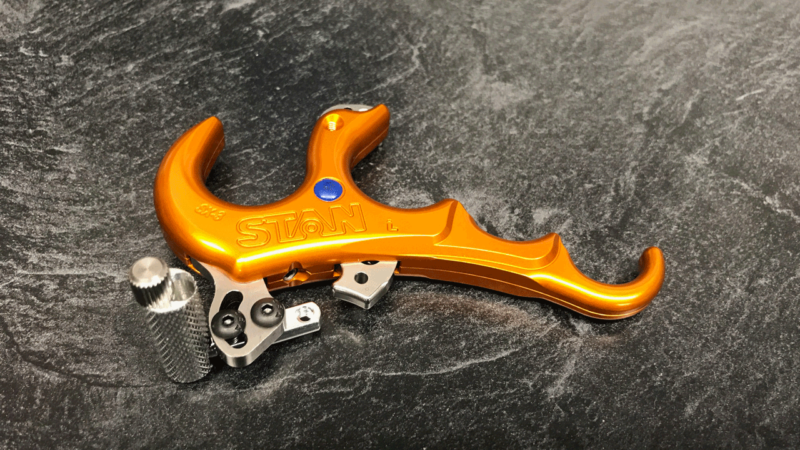So you want to switch from a wrist-strap, index-finger release to a handheld thumb trigger, eh?
This is a change many bowhunters make at some point during their bowhunting careers for a number of reasons.
Some like the idea of having a handheld release that they can clip to the D-loop on the bowstring and leave there until it’s time to shoot, as opposed to always having that wrist strap connected to your arm.

Others have noticed they tend to anticipate the shot and punch the trigger with an index release and they hope the thumb trigger will help them quit doing that. Still others are fighting target panic and they hope to kill it by changing release aids. And some just want to try something different.
It doesn’t matter how you got here, now you’re here. And so it’s important to understand that changing from an index finger release to a handheld thumb trigger is going to change more than just the device in your hand.
The most immediate difference you’re likely to notice is the feel of your draw length. It might feel shorter or longer depending on where you anchor with each release and where the release head sits when you’re at anchor.
You can fix this with cable twists, changing the length of your D loop or simply changing the draw length. Do what you need to get the draw length right for the release you’re shooting.
Peep height is something that needs to change for me when I switch from an index release to a thumb trigger. If I don’t move it, the peep sits too high when I pick up the thumb trigger. I have to move it down to get it right.

Something else you might encounter is left-right impacts. Depending on where the release head sits and how it actually releases the string, your arrows might impact the target left or right of where they would with the index release. Easy fix here. Just move your sight.
Also don’t be surprised if your bow’s draw weight feels heavier. The wrist strap on an index release allows your arm to help in the drawing process. With handheld releases, your hand is doing all the pulling and that can make a bow feel like it’s drawing heavier. Easy fix here though. Add a wrist strap to your handheld release if you want.
Arguably the biggest change from an index release to a thumb trigger is in activating the release. What you don’t want to do is trade punching an index release for punching a thumb trigger.
I mean, punching either release is fine if you can control it. Kyle Douglas, Jimmy Lutz and Tim Gillingham are three of the best command-style target archers and bowhunters in the world. But what we’ve seen across archery, however, is that it takes a very disciplined archer to control a shot on command. For most of us, the surprise release works best.
So how do you do that with a thumb trigger?

One of the simplest activation methods is to curl your thumb around the thumb barrel and then simply keep pulling with your whole arm until the release fires. Your thumb is on the trigger. Pulling with your arm achieves the same result as simply twitching your thumb to get the release to fire. However, when you pull with your whole arm, you can stay relaxed and focus on the target.
Practice this enough, and you’ll find your brain will make sure you’re on target when the release fires. When you punch the trigger, your body is tense and waiting for the pin to sit exactly where you want it so you can slam the trigger real fast.
A subtle, alternate version of this pulling method is to squeeze your hand, like you’re squeezing a tennis ball, as you pull through the shot. When you squeeze your hand, the release will fire.

Another method is to lock your thumb on the barrel of the trigger at full draw and then relax your whole hand, except for your thumb. The best explanation of this method I’ve heard is that you picture yourself hanging by your hand from the monkey bars. Then relax your hand so your fingers slip off the bars.
Naturally you won’t actually let the release go altogether. But as your hand relaxes, the bowstring will move forward, which will pull the release into your locked thumb and the trigger will fire.
None of these methods is more “right” than another. You have to figure out what works best for you. Again, what you want to avoid is simply smashing the trigger when your pin gets close to your aiming point.
Thumb trigger releases typically come with three-finger handles or four-finger. That is, you grip the release either with all four fingers or the first three next to your thumb. Again, personal preference dictates what’s right for you. The reason some choose three-finger handles over four is that the more narrow your hand is on the release, the easier it is to pull straight back. Some target archers actually prefer two-finger handles because they feel they can get an even straighter line.
But adding the pinky to the mix can really throw some folks off with their pulling. Play with a couple releases at your local pro shop, or borrow a couple different types at the archery club to see what feels most comfortable in your hand.
Changing from an index release to a thumb trigger can help improve your bowhunting accuracy. You’ll never know unless you try.

 By
By 



